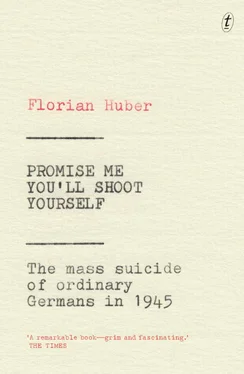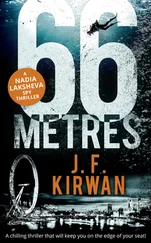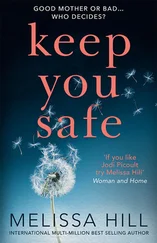Few of the accounts in the collection are as extensive or detailed as von Lehndorff’s journal, but they nevertheless confirm his experiences in Königsberg. All along the roads leading west, men and children and women and soldiers hanged or drowned or poisoned or shot themselves or each other, together or alone.
In the town of Liebemühl, for example, a family was found united in death: ‘Dead bodies sitting on the sofa, draped over chairs, lying in the beds.’
In the district of Osterode: ‘Shudder after shudder ran down our spines. If I had any poison, one man said, I’d poison myself and all the family.’
In the West Prussian city of Elbing: ‘The most senior constable said absently that Herr Hauptmann had shot himself at the command post last night.’
In the town of Tempelburg: ‘In the course of the morning, the landlord came back inside from his garden and said that there were four corpses (men and women) under a tree in the garden and three corpses hanging in the tree.’
In Treptow, near the Baltic: ‘When I said goodbye, he said: “This is the last time we’ll see each other.” He seemed to have made up his mind. He didn’t leave his place of work and I later heard that he’d ended his life that very day.’
In Belgard in Middle Pomerania: ‘Mass graves had been dug in the cemetery because there was no other way of burying the corpses. A lot of people had taken their own lives.’
In Lauenberg: ‘It’s hardly surprising that about 600 inhabitants chose to die on that terrible night.’
In Occalitz in Pomerania: ‘In the forest alone, 62 people from Occalitz went to their deaths—they drowned in the lake, were shot by Täger the forester, took poison or hanged themselves.’
In Labischin: ‘Several Germans, especially Baltic Germans, committed suicide on the very first day, some together with their entire families—taking poison or slitting their wrists.’
In Kurzig in East Brandenburg: ‘Young Frau Lemke shot herself and her two children. Her husband was a soldier. He’d left her his pistol.’
In Lossen in Lower Silesia: ‘In her despair, the master tailor’s wife Frau Pfeifer hanged her three children, aged between eight and thirteen, and then herself.’
Near Breslau: ‘In the night, I poisoned myself with Quadronox (approx. 10 pills), but unfortunately came round again three days later.’
In the Silesian city of Liegnitz: ‘Countless suicides were committed over the course of those days. My daughter and a woman with two little girls wanted to do it too. The desperation was indescribable.’
In Possen in Lower Silesia: ‘My uncle, mother and younger brother committed suicide by shutting the coal-fired stove too soon. They wanted me to go with them, but after a while I could bear it no longer and ran away.’
In Sternberg in the Sudetenland: ‘The list of people who have committed suicide out of fear of the Russians is growing longer and longer.’
In Mährisch Schönberg: ‘On the evening of 8 May our landlady hugged my wife and said: “Now we’ve put the worst behind us.” Later she and her husband chose to commit suicide.’
• • •
Only a few years separate such accounts from the experiences they describe. When people came to record their memories, they were still reeling from what they’d been through, and the suicides’ personalities, motives and past histories merge into a blur, subsumed by the chaotic end of the war and the arrival of the Soviet army. Occasionally, though, an eyewitness account gives you a sense of the state of mind of these people on the edge of the abyss. One such account is the story of Johannes and Hildegard Theinert.
Johannes Theinert was a Latin teacher in Glatz, an elegant baroque and Renaissance town in south-west Lower Silesia, tucked away in the Neisse basin, not a hundred kilometres from the city of Breslau. His house was by the river, and he would sit on his balcony and look down at the gentle eddies of the water. Popular with his pupils, he had a plump, open, kindly face, somewhat at odds with his neatly trimmed Hitler moustache, and he invariably wore an old-fashioned suit with a spotted tie. In 1936, aged fifty-three, he had married Hildegard Linke. A year later he began a diary, which he kept until the end of the Second World War—and not a day longer.
The last entry is in his wife’s handwriting. On 9 May 1945, the day the Germans capitulated, Hildegard Theinert took up her pen and wrote: ‘The war is over. The guns are silent.’ She had seen the German soldiers flooding back, singly or in groups, as they headed for the mountains in the west; she had seen the straggling refugees, following one route or another, and often getting held up along the way. Otherwise, the people of Glatz had remained untouched by the war. No bombs, no fighting, not a single shot fired. No foreign soldier had yet set foot in the town. And yet the Theinerts found it hard to rejoice in the end of the war, or their escape. ‘The rumours are coming thick and fast,’ Hildegard Theinert wrote. ‘Everywhere the same anxious question: “What next? What will become of us?”’
It wasn’t anti-Bolshevik propaganda that had them frightened of the advancing Russians; the two of them had seen through that from the start. It was, instead, something the propaganda had kept from them. A few weeks before, Hildegard and Johannes Theinert had learnt that the Russian soldiers had every reason to feel hatred and anger towards the Germans; they now had no choice but to believe the horror stories circulating in town.
Three weeks earlier, a former pupil on leave in Glatz had paid a visit to his beloved Latin teacher. He had come straight from the Eastern front, where, during his long years as a soldier, he had witnessed atrocities committed by both sides. The teacher and his wife listened in silence to his stories of Soviet villages burnt down by the Germans, scorched fields, hanged ‘partisans’ who were little more than children, wounded men shot in the neck to put them out of their misery, starving prisoners and the Soviets’ acts of retribution. They remained silent when he began to report on events behind the front lines. A lot of what the soldiers had seen and been through behind the front, in German territory, had so far only been hinted at back at home, but now that the end was in sight, they were done with being cautious and no longer inclined to spare their audience. The onetime pupil now assumed the role of teacher and taught his former schoolmaster the whole horrifying truth. He told him of the foul pits, the piles of clothes, the long queues of desperate people, the watchtowers behind barbed-wire fences, the murderous soldiers in German uniform.
Although many of the places the former pupil mentioned were only names to them, the Theinerts understood how closely they were implicated—how much this was their own story. ‘SS, field gendarmerie, special units, the execution of countless Jews, the treatment of Russian POWs, what went on in the concentration camps—hatred will soon be upon us,’ Hildegard would later write. The young man had brought the war into their peaceful living room overlooking the river, and with it crimes and guilt. There might have been an element of reproach in his tale: many of Herr Theinert’s pupils had found it hard to understand that such an esteemed and respected master had gone to teach at an Adolf Hitler school, an establishment catering to the Nazi elite.
When the pupil left at last, there was little need for discussion. The couple knew that their world would never be the same again. In her diary entry of 9 May, Hildegard Theinert wrote:
Johannes had listened to it all in silence. All evening and into the night he sat pale and slumped at the window, staring down into the Neisse, like a man turned to stone. We exchanged only a few words that evening.
Читать дальше












